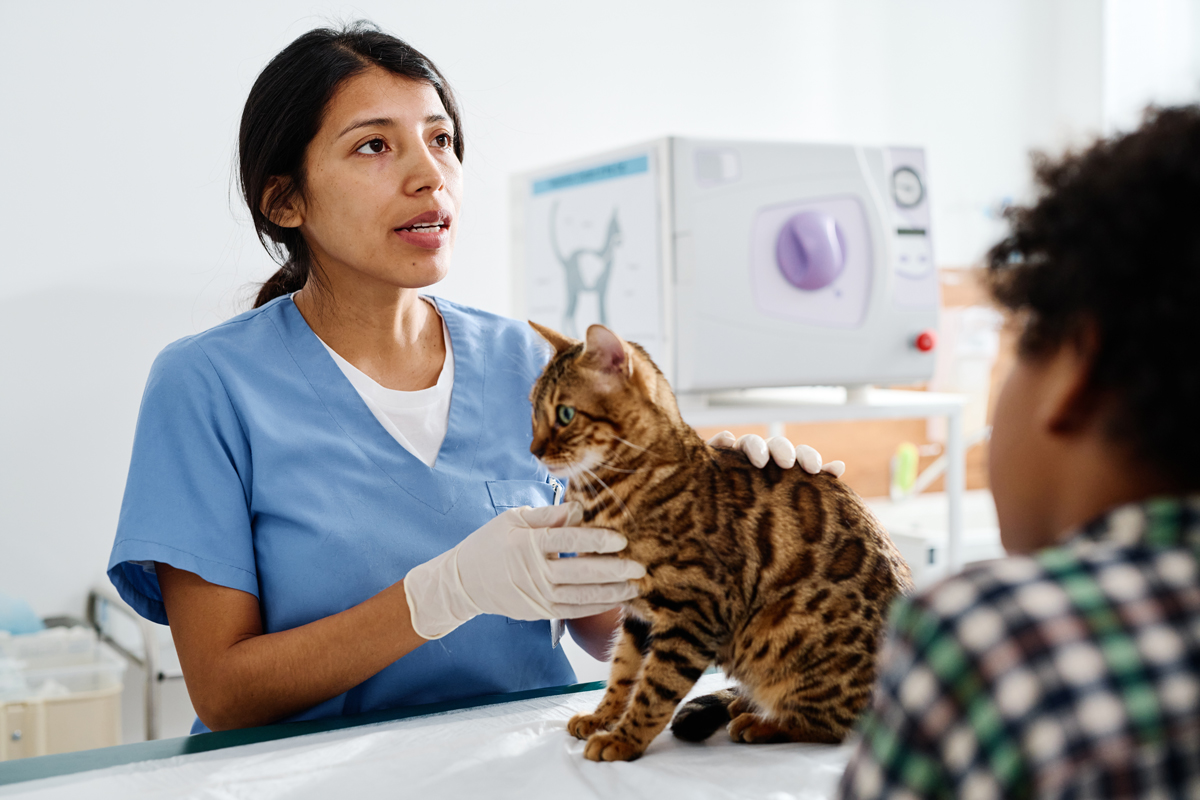A four-part “from the trenches” series, written by a Fear Free veterinarian for Fear Free veterinary professionals.
This is Part Three of a four-part series on helping Fear Free Certified Veterinary Professionals handle patients with high levels of FAS and communicate with their owners.
By Julie Liu, DVM
Communicating with clients is an art and can be especially difficult when managing a high FAS patient. Clients don’t always see what we do when it comes to signs of FAS, and they may have different priorities or ethics as a pet parent compared to us as Fear Free practitioners. Words such as “fearful,” “anxious,” or “stressed” may seem meaningless or exaggerated from their perspective.
Communicating Fear Free techniques should start with a discussion of body language, which transforms emotional abstracts into non-judgmental, objective observations that the client can see and hear. You don’t have to be a veterinary professional to witness when a dog is panting and whining or when a cat has flattened ears and dilated pupils. Once the client understands the body language of FAS, we can then communicate the implications of untreated FAS and suggest interventions.
One common scenario is when a pet’s FAS levels escalate during a visit, and none of the Fear Free techniques you’re using are helping. At this point you need to initiate a client discussion about PVPs, sedation, or otherwise changing the initial plan to achieve a Fear Free approach.
This can be stressful because you can’t predict the client’s reaction. Will they be open? Angry? Frustrated? Shocked and skeptical, because “They always do great at the vet!” and “No one’s ever mentioned anything before.” As discussed in Fear Free level 2 module 415, understanding the client’s needs and finding ways to meet those needs will help the pet parent get on board with your recommendations. For clients with time constraints, offer a drop-off slot or reschedule with PVPs on a day that works for them. For clients with budget concerns, consider invoicing a lower, “brief exam” fee for the follow up and setting in-hospital PVPs/sedation fees at a price that improves compliance. For clients who feel embarrassed or upset about their pet’s FAS, normalizing signs of FAS and using success stories of your own pets can help clients relate.
Think creatively and have some flexibility when making a plan for a client. I recently saw a dog for acute, non-weight-bearing lameness in a rear leg. While I suspected a torn CCL, on examination the dog was so tense and anxious that I couldn’t be sure. I recommended sending the dog home with pain medications and returning them for sedated rads and a repeat orthopedic exam, but the client had budget concerns, time constraints, and concerns about sedation. We made a plan to administer gabapentin at drop off, wait a couple of hours, and then give an opioid injection about 20 minutes before trying the rads, with the agreement that we would not continue if the dog was still painful or stressed. The tech informed me that she was unable to administer gabapentin because the dog was trying to bite. I asked the client to return to the clinic to help us give the medication, and when the client offered the meds in a treat, the dog took them immediately. After an hour, he was lying down sternally in his kennel, had stopped whining, and was coming to the front of the kennel for petting. When it was time for his rads, we still placed a basket muzzle as a precaution, but the dog was an FAS of 1, semi-sedate, eating treats, and much more amenable to the ortho exam and imaging. It wasn’t my initial plan, but it still worked for the client and the pet, who did have a torn CCL.
According to the AVMA Language of Veterinary Care Initiative16, “Clients want a strong relationship with their veterinarian. To clients, the word ‘relationship’ signals that the veterinarian is trustworthy, will make their pet feel comfortable, and goes out of the way to provide personalized service.” Focusing on long-term thinking and relationship-building can also help with client communication and Fear Free, especially for high FAS pets. We’re not just thinking about how to get through this visit, we’re thinking ahead to the next 5 or 10 years of vet visits. If we push your pet now when he’s already so stressed, the next visit is going to be that much harder for him. We want to build a relationship with you and your pet, and provide them with a lifetime of humane veterinary
This article was reviewed/edited by board-certified veterinary behaviorist Dr. Kenneth Martin and/or veterinary technician specialist in behavior Debbie Martin, LVT.
Julie Liu is a veterinarian and freelance writer based in Austin, Texas. In addition to advocating for fear free handling, she is passionate about felines and senior pet care. Learn more about Dr. Liu and her work at www.drjulieliu.com.
Continue learning about managing patients with high FAS through Part One, Part Two & Part Four of this series.
Want to learn more about Fear Free? Sign up for our newsletter to stay in the loop on upcoming events, specials, courses, and more by clicking here.
Resources
- Moral stress the top trigger in veterinarians’ compassion fatigue | American Veterinary Medical Association
- https://journals.sagepub.com/doi/full/10.1177/1098612X221128760
- https://fearfreepets.com/pain-and-fear-two-sides-of-the-same-coin/
- https://icatcare.org/our-campaigns/pledge-to-go-scruff-free/
- https://fearfreepets.com/treat-ladder/
- https://fearfreepets.com/top-10-treats/
- https://fearfreepets.com/wp-content/uploads/delightful-downloads/2019/01/Keep-Calm-and-Muzzle-On-1.pdf
- https://fearfreepets.com/courses/fear-free-certification-program/
- https://fearfreepets.com/courses/fear-free-certification-level-3/
- https://fearfreepets.com/fas-spectrum/
- https://fearfreepets.com/wp-content/uploads/delightful-downloads/2020/08/Dog-Sedation-Pain-Algorithm-2020.pdf
- https://fearfreepets.com/wp-content/uploads/delightful-downloads/2020/08/Cat-Sedation-Pain-Algorithm-2020.pdf
- https://fearfreepets.com/calming-pet-owners-concerns-sedation/
- https://www.felinegrimacescale.com/
- https://fearfreepets.com/courses/fear-free-level-2/
- https://www.avma.org/resources-tools/practice-management/communicating-clients-using-right-language-improve-care
- https://fearfreepets.com/resources/fear-free-store/fear-anxiety-and-stress-spectrum-cat/
- https://fearfreepets.com/resources/fear-free-store/fear-anxiety-and-stress-spectrum-dog/
- Moses L, Malowney MJ, Wesley Boyd J. Ethical conflict and moral distress in veterinary practice: A survey of North American veterinarians. J Vet Intern Med. 2018 Nov;32(6):2115-2122.
- https://www.youtube.com/watch?v=ExaL-pp9Kok&t=1531s






